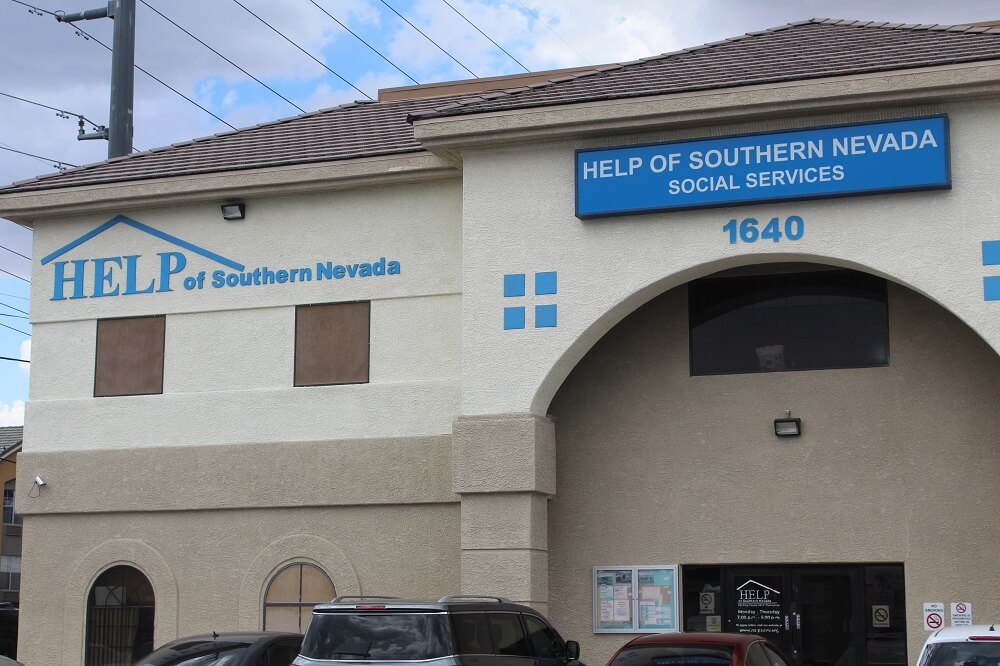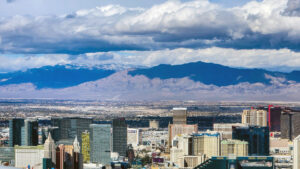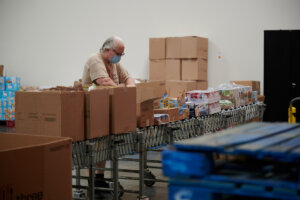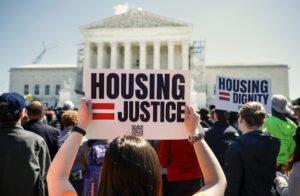Last week, HELP of Southern Nevada received a call from a 92-year-old man whose air conditioner broke in the triple-digit heat.
“He had been sitting in his home for three days,” says Kelly Robson, the chief social services Officer with the nonprofit. “That’s not good for anyone, especially a 92-year-old.”
Bob Cleveland, the executive director or Rebuilding Together Southern Nevada, gets similar requests all the time from seniors.
“We had one (senior) call today who has gone a year without air conditioning,” he adds. “That’s not uncommon.”
This past fiscal year, Rebuilding Together received about 500 requests from low-income seniors needing critical improvements to repair air conditioning, roofs and plumbing while HELP of Southern Nevada got about 30 requests from low-income seniors specifically needing air conditioning repairs this calendar year.
“The need is unreal,” Cleveland says.
It is difficult, if not impossible, for people to fix a broken air conditioning unit if they are living on a fixed income, which is why HELP of Southern Nevada and Rebuilding Together helps clients with repairs.
“Without those services, for our seniors especially, it would be a life or death situation,” says Abby Quinn, who is also with the organization. “Unless they had alternate housing, their chances of living through high heat and no reprieve would be very low.”
There were 123 heat-related deaths in Clark County in 2017 according to the Southern Nevada Health District. That’s an increase from the 78 reported in 2016. About 40 percent of those deaths occurred in July making it the deadliest month.
“We aren’t sure why there was an increase,” says Kathryn Barker, an epidemiologist with the Southern Nevada Health District. “It could just be an outlier and never happen again. That’s why we are on the lookout.”
The office of epidemiology and disease surveillance doesn’t include income level or housing status in the death rates, but health district officials say heat poses a threat to vulnerable populations such as low-income households, those experiencing homelessness, seniors and young children.
If the air goes out, it isn’t easy or quick to fix, especially for people who need assistance from organizations like for HELP of Southern Nevada or Rebuilding Together.
“If you call the repair company, you’re looking at $6,000 to $8,000 to replace it,” says Robson with HELP of Southern Nevada.
In 2017, the nonprofit had 35 people who had air conditioning emergencies, about 30 of them were seniors.
She adds the organization works as quickly as possibly to address the situation, but calls are prioritized for households with seniors or with children 6 and under.
In addition to low-income seniors, Rebuilding Together Southern Nevada helps veterans and disabled people with home repairs, which can be anything from fixing the plumbing to heating and air conditioning.
“Sometimes if they are in a specific area, we can’t help them,” Cleveland says.
That has to do with funding and the way community block grants are written. Money allocated by municipalities requires the organization to keep repair dollars in those areas.
“So we’ve had to turn people away,” he adds.
Cleveland says this is the first year the organization has received community block grants from each municipality, which has allowed the organization to help more people.
Even with more grant money, they’ve had to turn people away.
“We rarely have money after May,” Cleveland adds.
Yes, there is a difference between 104 and 105
Even if an air conditioning unit is operational, if low-income families can’t afford high power bills during the summer they can face disconnections.
NV Energy and nonprofits alike offer assessments to help people make their homes more energy efficient – that’s anything from weatherizing the house to switching out light bulbs. NV Energy had nearly 10,000 customers receive assessments in 2017.
For some, it might be too late if they already have past unpaid balances. Restoring service means paying the entire amount and a reconnection fee.
Under Nevada law, utilities are required to postpone disconnecting service when there is extreme heat, deemed 105 degrees under Nevada Administrative Code – for mobile home communities, it’s 100 degrees.
But 104 degrees is still hot, and a home without air conditioning or with disrupted power service can be hazardous.
Other cities with high temperatures have protocols similar to Nevada’s. In Phoenix, the Arizona Public Services Electric Company won’t disconnect if there is an extreme heat warning. The company uses a formula that takes into consideration heat, wind and humidity to determine if it would postpone a disconnection.
There are some assistance programs in Nevada to help households contend with high power bills, and potentially avoid having their service disconnected.
The state offers an Energy Assistance Program, under which households can get a one-time payment for their energy bills each year. Payment is made directly to the energy provider.
The program is partly funded by a block grant from the Low-Income Home Energy Assistance Program through the U.S. Department of Health and Human Services.
There is no guarantee Nevada will continue to get the funding in the next fiscal year. The current budget proposal from the White House doesn’t include funding for the block grant.
“Both the House and Senate versions do, so we will see what is reconciled,” says Julie Balderson with the Division of Welfare and Supportive Services in the Nevada Department of Health and Human Services.
A second funding source was created by the Nevada Legislature in 2001, which established the Universal Energy Charge. “It was built in because federal block grants can be unstable,” she adds.
A surcharge is put on utility bills. The Division of Welfare and Supportive Services receives 75 percent of the money — about $9.7 million in 2017 — for the Energy Assistance Program. The remaining 25 percent goes to the Nevada Housing Division for weatherization programs to make housing more energy efficient.
There were 25,635 households approved for the program in 2017, down from 26,936 in 2016. “Seventy-five-percent of applications are approved,” Balderson says. “The No. 1 and No. 2 reasons they would be denied are because they are over the income level or we ask for additional information, like copies of their current cooling and heating bills, and they don’t respond.”
Household annual incomes can’t exceed 150 percent of the federal poverty level, equal to $18,200 for an individual or $37,650 for a family of four. Only Nevada residents and U.S. citizens are eligible and priority is given to the most vulnerable households such as those with seniors, people with disabilities and young children.
How much a household receives depends on size, but the average yearly benefit is about $600 according to Balderson.
But these are options if people have homes.
Homeless in the heat
Sitting under a canopy in Huntridge Circle Park one July afternoon, 45-year-old Antonio Standifer, who has been homeless for six months, is struggling with leaving the comforts of the shade to face the heat.
“Yesterday, I was walking 30 minutes in the sun and felt like I was going to die,” he says. “It’s hard surviving out here.”
There isn’t any other choice. He has to make it to the plasma center so he can donate and get a few bucks.
For those living on the streets – an estimated 25,000 people were homeless in Clark County in 2017 according to the Southern Nevada Homeless Census – they can vie for a spot in one of the three day shelters that holds less than 500 people altogether.
That’s Salvation Army, Catholic Charities of Southern Nevada and The Shade Tree. Though Las Vegas Rescue Mission has an overnight shelter, it doesn’t offer a day shelter.
When there is an excessive heat warning, ten other temporary “cooling stations” open at recreation centers in Henderson, North Las Vegas and the City of Las Vegas.
Other than that, it’s just the three main shelters that are open daily.
The earliest option opens at 7 a.m. and the latest closes at 7 p.m. — the time a day shelter closes usually coincides with the time people can start accessing nighttime shelter beds.
While people are more at risk of succumbing to heat-related deaths during the day, Barker says nighttime can still be hazardous.
Salvation Army is the only facility that is open to both men and women, though in separate lounge areas. Catholic Charities is only opened to men and The Shade Tree is for women and children.
If people don’t want to go down to, or can’t get to, Foremaster Lane and Owens Avenue, where the shelters are located, they are forced to take refuge wherever they can.
“Their options are very limited,” says Emily Paulsen, the executive director of the Nevada Homeless Alliance. “That’s why they use public spaces, like libraries and community centers. That’s the only other option.”
Angel Flores, who has been homeless almost a year, says he spends most days hiding from the sun under a tree at Huntridge Circle Park. “The heat can be exhausting,” he says. “So it’s nice to stay here.”
Dozens of people are scattered throughout the park doing the same thing.
Though it is nice for the moment, Standifer says this will only provide respite for a little bit. When the park closes, that means finding a new place to go. For him, that might be a casino to spend his last dollar in the penny slots. “You learn tricks on how to keep inside,” he adds.
Paulsen says the solution shouldn’t be more quick fixes for them to just simply survive the heat.
“We should be creating more affordable housing,” she adds. “Nobody should be left out in the heat to die.”
Our stories may be republished online or in print under Creative Commons license CC BY-NC-ND 4.0. We ask that you edit only for style or to shorten, provide proper attribution and link to our website. AP and Getty images may not be republished. Please see our republishing guidelines for use of any other photos and graphics.




